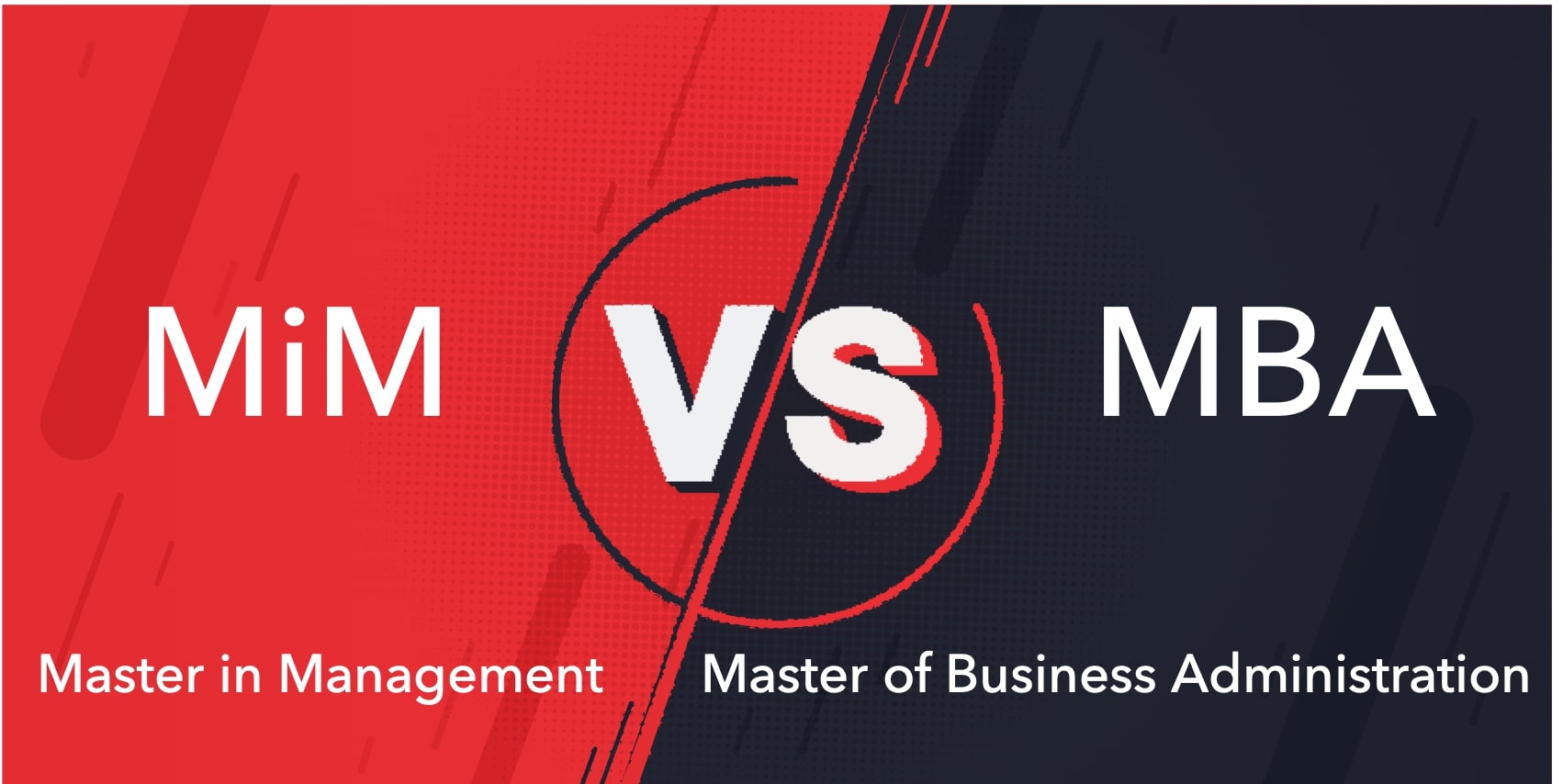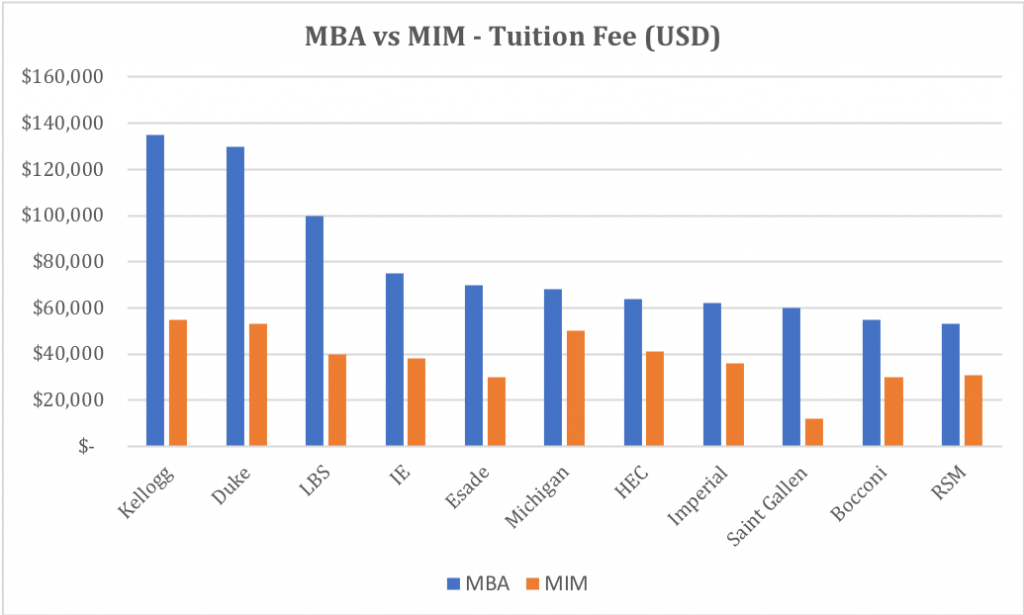Anna, who has recently completed her bachelor’s degree, aspires to climb the corporate ladder. She wants to pursue management education but doesn’t have enough work experience on her resume. She has recently started considering MiM (Master in Management) as an alternative to the good old MBA. However, she is not sure which of the two programs is a better fit for her – MiM or MBA?

Like Anna, many individuals in their early twenties, face the same dilemma – MiM vs MBA. The answer to this question lies in understanding the differences and then making an informed decision. Master in Management (MiM) programs are touted as mini-MBA or alternative to MBA, but several fundamental differences exist between the two. Let’s understand these differences.
Here are the various aspects we would cover in this article –
- Work Experience and Age
- Course Duration and Curriculum
- Cost of Education
- Choice of Specializations
- Employment Opportunities and Salaries
- Scope of MiM vs MBA
- Can I do MBA after MiM?
- MiM vs MBA – Which program should I choose?
Here are the 5 key differences between MiM and MBA:
- Average age
- Average work experience
- Course duration and structure
- Cost of attendance
- Career prospects and salaries
MiM vs MBA – Work Experience and Age
Work Experience
MiM courses cater to students with a bachelor’s degree who intend to study the nuances of business but do not have the required work experience to reserve a seat in an MBA program.
88% of MiM applicants have less than 3 years of work experience – with 38% having no work experience at all. It is in stark contrast to the MBA program, in which 60% of the applicants have more than 3 years of work experience.

(This data above has been taken from GMAC application trends survey report 2017, which compares work distribution of applicants of MiM vs MBA programs.)
Applicant Age
These numbers also give an insight into the average applicant age for MiM and MBA programs. The average applicant age for MiM is 23 years as compared to 27 years for MBA programs.
MIM vs MBA – Course Duration and Curriculum
Course Duration
MiM is fast-paced management program which is aimed at providing students with the necessary skills to enter the job market faster.
The duration of MiM programs ranges from 10 months to 24 months. But, most Business Schools offer 10-month programs. Kellogg, IE Business School, Esade, Duke, Michigan Ross are few top business schools which offer 10-month MiM programs.
However, few business schools offer longer and comprehensive MiM programs. For example – HEC offers an 18-month MiM program and LBS offers a 12-month MiM program.
Curriculum
MiM programs focus mainly on theoretical understanding through classroom lectures, guest lectures, case studies, and group projects.
“Duke, Fuqua School of Business explains its MIM program’s teaching method, as a mix of lecture, case studies, exercises, strategic games, corporate visits, and guest speakers. Professors use actual business problems to help you consider solutions, and you’ll also learn from real-world projects—like creating a marketing plan to launch a new Burt’s Bees toothpaste. Because so much of your learning happens through debate and analysis, you’re expected to be an active participant in class discussion. This approach challenges you to think practically, critically, and creatively, preparing you to tackle business problems from multiple perspectives.”
Internship opportunities, which are a part of nearly all MiM programs, give the students a chance to apply these skills in analyzing and providing solutions to various challenges faced by organizations.
On the other end, MBA programs are heavily focused on case studies, with emphasis mainly on the practical application of theory on real-life business complexities. This teaching methodology gives students ample opportunities to apply learnings from their pre-MBA work experience and assimilate it into the classroom curriculum.
Teseo, with a GMAT score of 750, received an admit to HEC Paris MiM program. Learn more about his GMAT Preparation journey in this article. A good GMAT score is the first step towards realizing your dream of pursuing a top MiM program. Sign up for our free trial and we can help you with quality content to prepare and personalized study plan. We are the most reviewed GMAT Prep company on GMAT Club with more than 1950+ reviews
Take a look at more GMAT success stories
MIM vs MBA – Cost of Education
 One of the other striking differences between MiM programs and an MBA is the cost of education, with the cost of Masters in Management programs totalling up to less than fifty percent of that of MBA programs.
One of the other striking differences between MiM programs and an MBA is the cost of education, with the cost of Masters in Management programs totalling up to less than fifty percent of that of MBA programs.
- The tuition fees for top 10 MiM schools globally range from $28,000 – $50,000
- On the other hand, the same for top MBA programs globally range from $40,000 to $130,000

MiM vs MBA – Choice of Specializations
The purpose of MBA programs is to build on the existing knowledge of their students. They offer a wide range of specializations and electives along with the core subjects. Anyone who wishes to dive deep into their areas of interest can opt for these electives.
However, the purpose of MiM programs is to build a business foundation for their students. Owing to the shorter duration of the programs and lesser experience of applicants, there are two types of MiM Programs:
- General MiM programs
- Specialized MiM programs
General MiM programs focus on core courses. The core courses offered are the same as that of MBA programs. Specialized MiM programs focus on a particular field of interest.
For example, Masters in Management of LBS is a general MiM program, whereas Masters in Financial Analysis (focused on Finance) and Global Masters in Management (focused on International Business) are specialized MiM programs.
MiM vs MBA – Employment Opportunities

MIM programs equip the younger and fairly inexperienced entrants with preliminary business skills to start off their careers at junior-level managerial positions.
MBA students, with extensive pre-MBA work experience, expect to be placed at mid-level or higher mid-level positions immediately after graduating.
Compared to MiM graduates, MBA degree holders command a higher remuneration in lieu of their previous work experience and a more sophisticated role they are expected to play in the organization.
Do you know, there is a positive correlation between your GMAT score and post-MBA Salary.
Learn more about the different factors affecting your post-MBA salary
| Salary Comparison – MIM vs MBA | |||||
| Master in Management (MIM) | Full-Time MBA | ||||
| School name | Country | Weighted salary (US$) | School name | Country | Weighted salary (US$) |
| University of St Gallen | Switzerland | 114449 | INSEAD | France / Singapore | 167657 |
| HEC Paris | France | 99145 | Stanford GSB | US | 195322 |
| IE Business School | Spain | 91189 | IE Business School | Spain | 168923 |
| London Business School | UK | 85262 | London Business School | UK | 154567 |
| Essec Business School | France / Singapore | 89067 | University of Cambridge: Judge | UK | 164462 |
| ESCP Europe | FR / UK / DE / ES / IT | 78215 | University of Pennsylvania: Wharton | US | 181634 |
| WHU Beisheim | Germany | 106172 | Columbia Business School | US | 172624 |
| Esade Business School | Spain | 74869 | Harvard Business School | US | 178113 |
| Università Bocconi | Italy | 75423 | University of Chicago: Booth | US | 168200 |
| Rotterdam School of Management, Erasmus University | Netherlands | 79248 | Iese Business School | Spain | 147596 |
According to FT 2017 Rankings, the average weighted salary of MiM degree holders from Top 10 schools ranged between $75,000 to $114,000 whereas, for MBA degree holders, the salary in the same period was anywhere between $150,000 and $195,000.
The table above undoubtedly illustrates that those who earn an MBA degree have a clear edge when it comes to salary as compared to those who receive a MiM degree.
Scope of MiM vs MBA
MiMs are recognized management programs that are very popular with European companies and have a lot of scope in European job markets. It is still gaining recognition in the US and India.
This article of Forbes talks about the rise of MIM programs in places other than Europe.
Many top business schools in the US, like Duke and Kellogg, are already offering MiM programs and other Business Schools are following their lead. As the alumni network of MiM graduates will increase, this program will only gain traction.
For Example – 97% of HEC’s MIM program students found employment within 3 months of completion. 35% found a job in Financial Services whereas 31% found a job in consulting.
When we talk about US Business Schools, 92% of students from Duke and 95% of students from Kellogg found employment within 3 months of graduation.
Can I do MBA after MiM?
Yes, you can. It actually makes more sense to do a 1-year MBA a few years after your MiM. After 4-5 years of work experience, you are more mature professionally to absorb the learning imparted during an MBA and undertake a more nuanced leadership training.
Pro tip: Just ensure that you pay specific attention to “Why the MBA” and the “Career Goals” portions of your essays when you do decide to apply for an MBA program.
Want to do an MBA? Learn on what factors admission committees judge your application.
MiM vs MBA | Which program should I choose?
Take a look at these 3 cases to understand which situation you relate to the most. It will help you make an informed decision.

Q – I am a 21-year old undergraduate with no work experience and want to pursue a management program. Is there an alternative to a full-time MBA program?
If you are young, inexperienced, and looking for a basic business degree, MiM is the right choice for you. At this point, you should check out a few general MiM programs.
Q – I am a 25-year old undergraduate with 3 years of work experience. I want to pursue a full-time MBA program, but I feel I am 1-2 years short of work experience to make a strong candidacy. Should I gain more work experience or should I pursue an MIM program?
At this point, the choice of the business program depends on what your long-term goal is. If you wish to specialize in your area of interest to boost your career, you may opt for a specialized MIM program.
If you want to advance your career in management and are not sure of the specialization, it is advisable for you to gain more work experience and contemplate your career goals.
Q – I am a 28-year-old, with 6 years of work experience, should I go for MIM or MBA?
You have a good number of years to show on your resume. At this stage, a full-time MBA might be more worthwhile as any full-time program would see value addition in their class with your learnings from the industry.
Takeaway
Irrespective of whether you choose MiM or MBA, you should remember that admission to both requires significant effort in the applications. A good GMAT score will always help to bolster your application. Why don’t you take a free trial of e-GMAT’s Prep course and take the first step towards a successful application?

Teseo, with a GMAT score of 750, received an admit to HEC Paris MiM program. Learn more about his GMAT Preparation journey in this article. A good GMAT score is the first step towards realizing your dream of pursuing a top MiM program. Sign up for our free trial and we can help you with quality content to prepare and personalized study plan. We are the most reviewed GMAT Prep company on GMAT Club with more than 1950+ reviews















